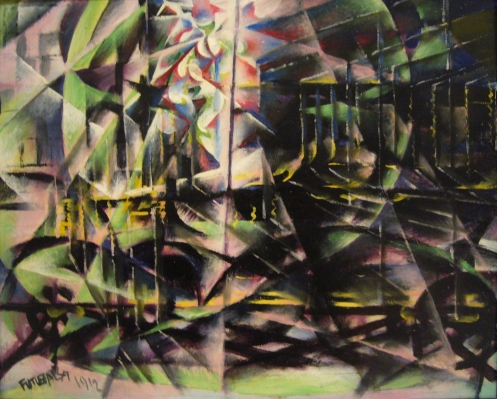Modernity & Modernism : an introduction
1760-1960 - Modernist project - philosophy of design.
We live in a postmodern world now.
Modern - positive connotation, improve to modernise, project of new and better.
Tate Modern, new labour new Britain.
New woman photomontage, Spanish Pavilion 1931, Paris International exhibition.

Will Holman Hunk 1851 - The Hireling Shepherd
The above image was the advent of industrialisation. New radical style at the time. Considered modern at the time but isn't modernist.
Paris, 1900 was the most advanced city on the planet. The city was dense, fast paced, populated.
The Eiffel Tower attempted to be modern and industrial.
Gallery de machines, new inventions, new technology - revels in modern and industrial aesthetic.
Trottoir roulant - electric moving walkway - Urbanisation (country to town transition).
City becomes a work place. Factories replace rural work. Rural, all day long work. Factory has shifts. City starts to develop own communication, roads, telegraph, railway, telephone.
1912 - world time was standardised to keep within the time tables of modernity.
Process of rationality and reason.
Enlightment - Period in late eighteenth century when scientific philosophical thinking made leaps and bounds and started to embrace new thinking. Religion and superstition was ditched for scientific facts [SECULARISATION] faith in self not God.
New forms of entertainment: cinema, shopping, music...
The city becomes product of our culture.

Caillebotte 1877 - Paris on a Rainy Day
Haussmanisation - Paris 1850's - new Paris
Old Paris architecture of narrow street and run down housing is ripped out. Haussmann ( city architects) redesigns Paris. Large boulevards in favor of narrow streets, which made street easier to be policed - social control. Also 'dangerous' elements of working class are moved outside the city centre. Centre becomes expensive middle class and upper class zone.
Subjects of paintings is the city - people in paintings gazing at city and buildings.
Scientists freaked out that modernisation would send people mad. Trains, roads, etc - experiment on attentiveness to sound location 1893/
Modernism brought:
- Affluence
- Alienism
- Class division rich/poor
- Inventions
- Steamship.
- Flaneur - wealth shown off by strolling around city. City is the site of enrichment and it became more confronted with class difference.
Fashion becomes a communicator; signifier of who you are.

Sheurat 1884-1886 - Sunday Afternoon on the Island of La Grande Jatte (pointillism)
At this time the whole idea of life changes, no working dawn till dusk, there are shifts instead, 'you time' is structured. The whole of life revolved around work.

Degas 1876 - L'Absinthe
Starts to look like a photograph, not centered, cropped, worker getting drunk because life is so rubbish.

Kaiser Panorama - 1883 - sit and look at images rather than sit and look at the world rather than go out an see it.
The Lumiere Bros - film of camera going up and down the Eiffel Tower. First film was of a train coming into a station and it had people screaming in the aisles.
Subjective experience - experience of individuals in the modern world. Starts to come close to understanding modern art.
Alfred Steglitz Flaitron building was built in 1900 in New York in a grid design. New building brought new views from above.

Paul Citroen 1923 - Metropolis
Edweard Muybridge - Descending stairs and turning around - 1884-1885 - new technologies used as a tool to scrutinise.

Giacomo Balla 1913 - The Speeding Automobile
Modernism in Design
- Anti-historicism.
- TRuth to materials - Eiffel Tower - no polish, looks industrial.
- Form follows function - function first then appearance.
- Technology.
- Internationalism - neutral language.
Anti-historicism - no need to look backwards to older styles
'Ornament is crime' - Adolf Loos 1908
Tattoos were seen as bad because of the need to decorate yourself.
Bauhaus - Renovate rules on art teaching and had the most progressive art school of the twentieth century.
Bauhaus building - futura font, windows for function, bare concrete.

Technology
- New materials
- Concrete
- New technologies of steel
- Plastics
- Aluminum
- Reinforced glass
Mass produced items made everything cheaper and more accessible.
Internationalism
- A language of design that could be recognised and understood on an international level - utopian aspect.
- System of neutralisation no matter where you are from.
Harry Beck - London Underground Map - 1933 - guide for function, distances not real on map, international design, neutrality.
Fraktor - Nazis front - invented in the 1930's. They shut down Bauhaus because they thought it was too progressive. Medieval, gothic, demonic race.

No comments:
Post a Comment